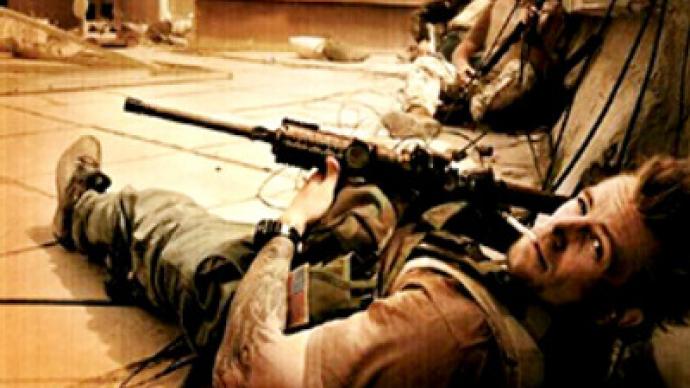Why Academy Award went to film about Iraq

Academy Award-winning film “The Hurt Locker” is sweeping the world as a kind of advertisement for the US army. But is it really an advertisement?
Iraq has no cinemas. Nor do the majority of people there have the time, electricity, or equipment to watch this film. This is actually a piece of luck for the US army – had the Iraqis seen this film, their guerilla count would have soared.
But let’s get back to the film.
The producers did not bother to make the scenery look like the actual Iraq. They do not know what Iraq, with its towns, streets, mountains and desert, looks like. They probably did not care. They probably thought you could just tape any Muslim city anywhere in the world and that would do.
And so the Hollywood view of the Muslims comes out like this: dark-skinned dirty people who look almost identical to cattle in a herd. That is how this film portrays the Iraqi citizens – as a mass seen from far away, and you cannot see individual faces.
Thus you get a lot of identical tiny Iraqis. And all men look just the same. And their elders are some ridiculous and scared midgets.
And they have neither individual faces, nor real names – nick-names at best – and as far from reality as Hollywood fantasies themselves.
For example, there is a boy nick-named Beckham. This never happens in Iraq.
There are no Iraqi people. Instead there is some sort of biomass emitting danger. The question why they are dangerous to the Americans is not considered, it is rather a statement taken for granted. They are dangerous. Period. To be disarmed or exterminated.
And that is what happens in this film – they are either disarmed or blown up.
The visuals are surprisingly dry. A view of an Iraqi teacher with a bomb on his chest moves just as little as that of a pile of shelves in a warehouse. That is all. He just gets blown up. No sentiments.
The American Explosive Ordnance Disposal staff are made look like superheroes against this grim background. Their challenging work is shown to the tiniest detail.
Young Americans must be raring to serve in the army after an advertisement like this.
Yet, non-Americans’ view of these soldiers is different – they see paranoid and hysterical individuals rather than superheroes. In other countries’ armies, such staff would be considered ineligible and sent to get treatment for neurosis.
It should be noted that real American EOD members also agreed that it takes a more balanced person to serve in an EOD unit than this film suggests.
Now, why don’t we take a closer look at some scenes?
For example, the film shows an EOD unit departing on a mission: one vehicle leaves for a destination in town; once there the staff gets out and starts the work.
In real life, occupation force vehicles never travel alone. The smallest unit consists of five vehicles. And everyone has to give way; otherwise they open fire for effect. You will never see children running toward the US military vehicles and cheering – children in Iraq know that it is lethally dangerous.
Once, I failed to notice a unit like this and started to cross the street. My guides grabbed me back and thus saved my life. I asked: “Why, what would have happened?”
”They’d just run you over, that’s what would have happened.”
”And they would get away with it?”
My guides looked down.
“But I posed no threat to them. I was just passing by.”
They kept silent.
Sometimes the US troopers go for some leisure shooting – shooting at people, vehicles. You can see such footage on the Internet, where it is uploaded by the soldiers themselves without any apprehension. No one opens investigations based on these videos. Why would they? There are no victims.
If Americans want to, they can stop the traffic anywhere, no matter if half a town has to stop for them.
They do nothing in the interests of the Iraqi people, absolutely nothing. Therefore, the film leaves it unclear why they remove mines from these roads and buildings. No one goes on any missions because there are no such missions in real life. The real-life EODs prefer blowing up buildings rather than risking their lives.
Everything is arithmetically simple.
An American is paid $100,000 a year for his service in Iraq, plus numerous bonuses. An Iraqi serviceman earns $5,000 a year at best. Ordinary Iraqis live on one or two dollars a day. Some of them do not even have that. So why should an individual worth $100,000 save a creature whose life costs one dollar from IEDs? The film makes this point exactly.
These simple thoughts do not occur to the audiences in America, but they do to people living outside the United States. These thoughts make hatred of America stronger.
It hasn’t always been so. The Americans used to know how to protest against wars waged by politicians. They knew how to shoot films whose best characters were tormented by thoughts about the political aspect of any war and its reverse side.
“Apocalypse Now” is full of such meditations. Perhaps those meditations weakened the US army, but they made America a charming country for millions of people and, consequently, made it stronger.
”The Hurt Locker” admires the feats of an American soldier. The whole world hates these soldiers who wonderfully perform their line of duty and are completely unwanted by America. Surprisingly though, the same Hollywood masters who used to create America’s positive image are now creating an antagonistic image of the United States, although they seem to think quite the opposite.
In another episode, a sniper views the surrounding area. Through his gun-sight he sees some Iraqis sending signals to other Iraqis. In addition, the Iraqis are filming something on a video camera. The film’s character who notices the Iraqi activities removes the sight indifferently.
It is completely the opposite in real life: any suspicious person in Iraq will first be killed and it’s only after some time that someone may think about whether or not that killing was really necessary.
The simple statistics of the war prove just that.
The United States has lost about 4,600 of its troops compared to more than 100,000 Iraqis who have been killed. These figures give an answer to the question whether an American soldier always removes his sight without shooting at a suspicious target.
The film’s director shows a character wandering around a night city all alone. He and other soldiers are inspecting a neighborhood on foot. The director also shows how they burst into the house of some old people and how a woman shoos the armed soldier away with a duster.
Nothing of this kind happens to the Americans in real life. They never set foot on Iraqi soil outside their military camps. They do not call on houses alone and never go out without leaving corpses behind.
American soldiers in Iraq have only one sacred wish: to be discharged. Their war has no place for exploits or heroism. That means film directors have to invent these things, and this is a complicated and thankless task. Very few people in the world can really grasp that, except the Americans themselves.
What are they doing in Iraq? Against whom and for what are they fighting there? The film does not raise these questions. No such questions arise in the heads of the American audience. But the whole world watches Oscar-winning films, and the answers that are brewing in the viewers’ heads are not in favor of the United States, which is so preoccupied with its negative image.Nadezhda Kevorkova for RT













